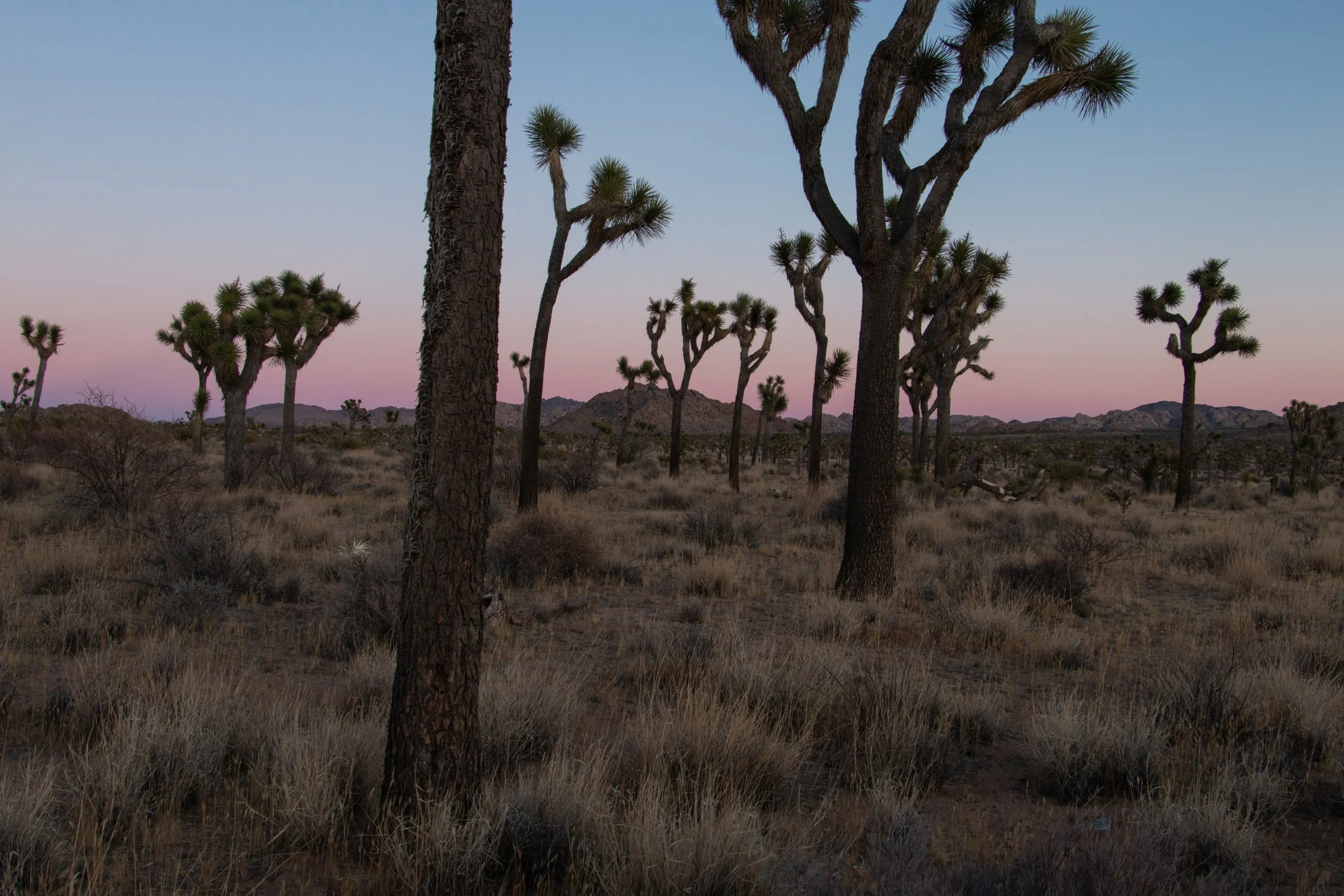Spring in Joshua Tree: Where to see wildflowers, sunsets and escape the crowds
Photography © Paul Martinez
As winter fades and spring takes over, the high desert awakens. Joshua Tree National Park, a land of sculpted rock and twisted yuccas, turns into an otherworldly paradise when the season hits its stride. Wildflowers ignite the sandy washes, the temperatures are perfect for long hikes, and the skies put on a show at sunrise and sunset. But with peak season also comes peak crowds—so if you want to experience the magic without the madness, here’s your guide to making the most of Joshua Tree in spring.
Where to Find the Best Wildflowers
Spring blooms in the Mojave are a fickle thing. Some years, they erupt in waves of purple, yellow, and pink; other years, they’re barely a whisper on the landscape. The key? Winter rainfall. If the desert gets enough water, wildflowers will put on a display that rivals the best alpine meadows. Even in drier years, though, you can still find pockets of color if you know where to look.
Cottonwood Spring – This low-elevation spot is one of the first to bloom, featuring desert dandelions, chuparosa, and the bright red spires of ocotillo.
Barker Dam – A short hike with a big payoff—wild lupines, beavertail cactus blossoms, and poppies sprout along the trail, framed by towering boulders.
Hidden Valley – A classic loop hike where flowers sneak through rock crevices and Joshua trees dot the horizon. Bonus: this is also one of the best spots for boulder-hopping.
Pinto Basin Road – For a scenic drive through wildflower country, this stretch of road can explode with blooms on wet years, especially near Turkey Flats.
Black Rock Canyon – A less-visited section of the park with yucca-lined trails and plenty of desert marigolds if you time it right.
Pro Tip: The best time to catch wildflowers is early morning, when the light is soft and the crowds haven’t arrived yet.
Photo by NPS | Renata Harrison
The Best Hikes to Tackle in Spring
With temps hovering in the comfortable range—think 70s by day, cool evenings—spring is the season to log some miles in Joshua Tree. Whether you’re in the mood for a sunrise summit or a trek to a hidden palm oasis, here are five trails worth the effort.
Lost Palms Oasis (7.2 miles round trip) – This hike leads to a rare sight in the desert: a lush, shady oasis of native California fan palms. It’s a long, rolling trail, but the solitude at the end is worth it.
49 Palms Oasis (3 miles round trip) – If you want an easier way to see an oasis, this shorter but steeper trail delivers. Keep an eye out for bighorn sheep on the ridges.
Ryan Mountain (3 miles round trip) – The go-to peak hike in Joshua Tree. You’ll gain 1,000 feet of elevation, but at the top, you’ll be rewarded with panoramic views of the park stretching in every direction.
Mastodon Peak (3 miles round trip) – A mix of history and scenery, this trail near Cottonwood Spring features old mining ruins and a short rock scramble to an epic viewpoint.
Cholla Cactus Garden (0.25 miles round trip) – More of a stroll than a hike, but if you hit it at sunrise, the cholla cacti glow golden like something out of a dream.
Pro Tip: Spring means perfect hiking weather, but the desert sun is still intense. Start early, wear sun protection, and carry more water than you think you’ll need.
Sunrise, Sunset and Stargazing Spots
Joshua Tree’s sky game is strong year-round, but in spring, the conditions are unbeatable. The air is clear, the colors are electric, and once night falls, the stars put on a performance that makes city lights look like a joke.
Best Sunrise Spot: Cholla Cactus Garden – The golden-hour glow on the cholla is unreal. Just be careful—these things are called "jumping cholla" for a reason.
Best Sunset Spot: Keys View – A high-elevation perch that gives you a front-row seat to the Coachella Valley and, on clear days, all the way to Mexico.
Best Stargazing Spot: Arch Rock – After dark, head to Arch Rock for a night photography dreamscape. Bring a headlamp and look up—no telescope needed.
Pro Tip: Spring nights can still be chilly. Pack a warm layer if you plan to stay out late watching the stars.
Photography © Paul Martinez
The Ultimate Scenic Drive
If you want to soak in the desert’s best sights without a long hike, hit the road. Joshua Tree’s scenic drives offer plenty of pullouts for quick stops and epic photo ops.
Pinto Basin Road – A winding route through some of the park’s best wildflower terrain. Keep an eye out for blooming brittlebush and desert lilies.
Park Boulevard – The main drag through the park, dotted with Joshua trees, massive boulders, and the occasional roadrunner darting across the road.
Queen Valley Road & Big Horn Pass Road – A quieter, dirt-road adventure where you’ll feel like you have the park to yourself.
Pro Tip: Visit on a weekday if you can—weekends in spring bring peak crowds.
Finally: How to Do Spring Right in Joshua Tree
Spring is hands down one of the best times to visit Joshua Tree. The weather is ideal, the landscape is alive, and every day brings a new reason to explore. But with popularity comes responsibility—stick to trails, respect wildlife, and leave no trace.
Whether you’re hunting wildflowers, chasing the perfect sunset, or just looking to escape into the quiet vastness of the desert, spring in Joshua Tree is nothing short of magic. Just be sure to pack water, hit the trails early, and take a moment to appreciate the way the desert wakes up this time of year.
See you out there.



